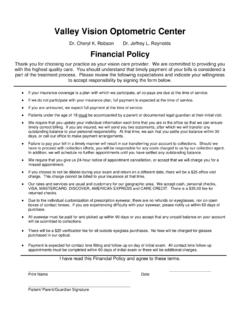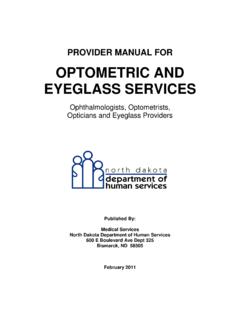Transcription of Kansas OptOmetric ssOciatiOn Low Vision …
1 Kansas OptOmetric Association Low Vision Resource Guide 4/10. 2010 Kansas OptOmetric Association Table of Contents Introduction and Acknowledgements ..3. Definitions ..5. Examination of the Individual with Vision Impairment ..7. Assistive Technology ..9. Radio Reading Services and Talking Book Programs ..11. State Services for the Visually Impaired ..13. National Resources ..15. Optometrists Providing Primary and Secondary Low Vision Care ..17. Occupational Therapists Accepting Low Vision Referrals ..21. Other Resources ..23. Low Vision Resource Guide 1. 2 Kansas OptOmetric Association Low Vision Resource Guide The Kansas OptOmetric Association (KOA), encourages all members to practice the full scope of OptOmetric practice, including the proper evaluation, management and referral of patients with visual impairment.
2 We realize that members have differing levels of experience when dealing with low Vision patients. We hope this guide will assist in your care of patients with impaired Vision . KOA Low Vision Committee members are available to assist with questions from members at any time. In addition, the Low Vision Committee has a presentation on Low Vision Care available for use by any KOA member. The Committee also has a speakers bureau that you can call upon for events across the state. Please contact the KOA office in Topeka at (785) 232-0225 for details. Low Vision Committee Members 2009-10. Chairman, Kendall Krug, Wayne Gilmore, Parsons John Metzger, David Nelson, Topeka William Park, Wichita Kristina Post, Wellington Gina Ridder, Hutchinson Amanda Strom, David Waldie, Wichita John Welsh, Salina Todd Zerger, Salina Low Vision Resource Guide 3.
3 4 Kansas OptOmetric Association Definitions Low Vision A patient is considered visually impaired or low Vision , when their visual ability does not allow them to read, drive or independently complete their activities of daily living. The Social Security Administration published new rules for visual disorders in the Federal Register (71 FR 67037) on November 20, 2006. These rules became effec- tive on February 20, 2007. As in the past, statutory/legal blindness continues to be defined as best corrected visual acuity of 20/200 or less in the better eye; or a visual field limitation such that the widest diameter of the visual field, in the better eye, subtends an angle no greater than 20 degrees, as measured with a Goldmann III4e or equivalent size stimulus.
4 Under the new rules, how visual acuity and visual field can be tested to meet this definition has changed. Under the new criteria, if a person's visual acuity is measured with one of the newer charts and they cannot read any of the letters on the 20/100 line, they will qualify as legally blind, based on a visual acuity of 20/200 or less. For example, if the person's best-cor- rected visual acuity for distance in the better eye was determined to be 20/160 using an ETDRS chart, they would now be classified as legally blind. Regardless of the type of test chart used, the person will not be classified as legally blind if they can read at least one let- ter on the 20/100 line.
5 For example, if a person's best-corrected visual acuity for distance in the better eye was determined to be 20/125+1 using an ETDRS chart, they would not be classified as legally blind because they were able to read one letter on the 20/100 line. For visual field testing, the following measurements can be used: 1. Automated static threshold perimetry (Humphrey 30-2 and 24-2). For Humphrey Field Analyzers, a 10dB stimulus is equivalent to a 4e stimulus. A. dB level that is higher than 10 represents a dimmer stimulus, while a dB level that is lower than 10 represents a brighter stimulus. Therefore, for automated static threshold tests performed on Humphrey Field Analyzers, any point seen at 10dB or higher are a point that would be seen with a 4e stimulus.
6 2. Kinetic perimetry, such as the Humphrey SSA Test Kinetic . The kinetic test must use a white III4e stimulus projected on a white apostilb (10 cd/m2) background. 3. Goldmann perimetry With a III4e target. (Continued on page 6). Low Vision Resource Guide 5. SSA will not use the results of visual field screening tests, such as confrontation tests, tangent screen tests, or automated static screening tests, to determine legal blindness. For visual acuity testing, the criteria changed because most test charts that use Snellen methodology do not have lines that measure visual acuity between 20/100 and 20/200. Newer test charts, such as the Bailey-Lovie or the Early Treatment Diabetic Retinopathy Study (ETDRS), do have lines that measure visual acuity between 20/100 and 20/200.
7 Vision Rehabilitation Vision rehabilitation is the process of treatment and education that helps individuals who are visually disabled attain maximum function, a sense of well being, a personally satisfying level of indepen- dence, and optimum quality of life. Function is maximized by evaluation, diagnosis and treatment including, but not limited to, the prescription of optical, non-optical, electronic and/or other treatments. The rehabilitation process includes the development of an individual rehabilitation plan specifying clinical therapy and/or in- struction in compensatory approaches. Vision rehabilitation may be necessitated by any condition, disease, or injury that causes a visual impairment which results in functional limitation or disability.
8 In addition to the evaluation, diagno- sis and management of visual impairment by an eye care physician (optometrist or ophthalmologist), Vision rehabilitation may include, but is not limited to, OptOmetric , medical, allied health, social, educational and psychological services. Approved by the American OptOmetric Association Board of Trustees, June 2004: The American OptOmetric Association supports the interdisciplinary approach to rehabilitation of patients with low Vision (legally blind and/or visually impaired). As part of the blind rehabilitation network, the optometrist plays an integral role through diagnosis and management of the low Vision patient and prescription of optical, non-optical and electronic devices to provide this population with optimal use of remaining Vision .
9 Optometrists who provide comprehensive low Vision care establish clinical treatment plans, including, but not limited to, pre- scription, training, education and interdisciplinary consultation. 6 Kansas OptOmetric Association Examination of the Individual with Vision Impairment In addition to the comprehensive ophthalmic examination, the eye care physician (optometrist or ophthalmologist) provides the following components of care: The extended case history. Diagnosis, qualification, and quantification of functional manifestations of ocular disease and level of visual impairment. Determination and prescription of treatment options, including, but not limited to, optical correction, magnification, selective absorption filters, and assistive devices/technologies to be integrated in a goal-directed treat- ment plan, including delineation of compensatory strategies and therapies Impression of prognosis of patient benefit from participation in a Vision rehabilitation therapy program.
10 Establishment and coordination of a plan of care, including specification of a schedule for physician follow-up to assess therapeutic outcomes and need for continued care. Recommended Evaluation Charts and Nomenclature: Distance Acuity: ETDRS style, using a 1, 2 or 3 M (10 foot). Preferred notation is test distance/letter size. The ETDRS chart for converting the number of letters read to a Snellen fraction 20/X number is included in the Resourse Section. The best corrected acuity (conventional prescription) will become the Visual Impairment level of each eye. Use the ICD- 9 codes in the 369. series. There is a Visual Impairment Codes Chart in the Resource section.




